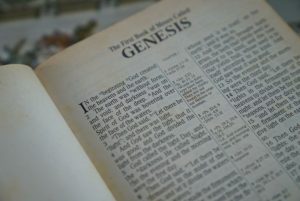Last week we looked at the content and outline of Genesis chapters 1-11 while referencing the apologetics background of those chapter for further study so that we can be equipped to defend what we believe to a culture of skepticism today. As exciting and fascinating as Genesis chapters 1-11 can be, both in content and apologetically, the job is not over when we begin Genesis chapter 12, in fact it has only begun.
As with much of the Old Testament most people are misinformed as to the history and teachings therein, and many lack a desire to really study it, I know cause I was one of them. However, with a little time and effort that changed with me, and I found that we can read through the books fairly easily, and the stories are great! Then the more we are willing to delve into the study of text the more God will teach us.
When I came to understand that the Old Testament was the key to the New Testament, and the person of Jesus, my reading and study of the Old Testament really opened up, and my understanding increased tremendously. It actually became easier when I knew the focus was on Jesus as the connection from the Genesis 3:15 Promise that was carried through individuals like Abraham and his descendants, the Nation of Israel, culminating in the first century AD with the birth, life, death, and resurrection of Jesus!
Let’s review from last week:
Genesis chapters 1-11 gives us the following:
- The First Four Major Historical Events:
Creation – Fall – Flood – Dispersion (Tower of Babel)
- The Major Players in these first four events:
Adam & Eve—Seth—Noah—Shem
- Two Major Theological Events/Covenants:
The Promise (Adamic Covenant/Curse)
And I will put enmity between you and the woman, and between your seed and her seed; He shall bruise you on the head, and you shall bruise him on the heel.” Genesis 3:15
The Noachian Covenant (The Covenant Promise is carried through)
But I will establish My covenant with you; and you shall enter the ark—you and your sons and your wife, and your sons’ wives with you. Genesis 6:18
The foundational book of Genesis is the most attacked book of the Bible by secular scholars, especially Genesis 1-11. Why?
If the foundations are destroyed, what can the righteous do?” Psalm 11:3
This week we’ll take a look at the person of Abram (Abraham) whom God called out of the land of Ur and into the land of Canaan with a Covenant Promise that can be traced back to the original Promise of Genesis 3:15.
Did Abraham actually exist?
Historical scholarship and Archeology gives us a definitive answer of yes. Abraham is the Patriarch of the three major religions: Christianity, Judaism, and Islam. Historical records in all three faiths point to the person of Abraham along with the following:
- The existence of a city of Ur of Chaldeae is identified by most archaeologist scholars as being Ur Kasdim which was the Sumarian city of Ur located about 200 miles southeast of present day Baghdad.
- The existence of the city of Haran is identified as modern Haran in Turkey.
- The existence of Shechem and Bethel has also been located and the travel from Ur to Bethel by Abram is easily possible.
- The Mari tablets are valuable corroborative archeological finds because they are dated from the same time period (2800-1760 BC/BCE) as the Biblical Patriarchs and from an area in the vicinity of Abraham’s homeland about 200 miles southeast of Haran. The tablets confirm some of the following:
- A reference of “Hapiru” (Hebrews in the area of that day)
- Similar practices such as adoption and inheritance laws that the Bible references
- The slaughtering of animals when covenants were made
- Pagan gods that are also named in the Bible
- Judges similar to the judges of the Old Testament
- Personal names such as Noah, Abram, Laban and Jacob
- Socioeconomic conditions at that time are the same as the Bible records
The dating of Abraham may be disputed, and we will cover that skepticism in later posts, but the places and practices are not in dispute.
Watch this short clip on the modern day location of Ur:
The Fifth Major Historical Event: The Period of the Patriarchs
The receiving of the Covenant Promise and The rise of the Hebrew Nation of Israel
Who are the Patriarchs?
When we speak of the Patriarchs we are talking about the people who are given God’s Covenant Promise and who carry the seed of the line of Jesus. This begins with Abram (Abraham) and goes through his son Isaac and then to his son Jacob (who’s name is changed to Israel). At the end of Genesis the focus will move to the Nation, or twelve tribes of Israel, and a story about one of the sons named Joseph.
Joseph’s story is important because it foreshadows Jesus in many ways, but it also gives us the reason that we find the people of Israel in Egypt when we move into the second book of the Torah – Exodus. However, Joseph is not the next in line to carry the promised seed, it is Judah. Judah’s story is dark and veiled, but by the end of the book of Genesis we find out why and how he becomes the chosen carrier of the Promised Seed.
Birth of the Patriarchs and major players in Genesis 12-50:
- Abraham c. 2166 BC – Genesis 12-25
- Isaac c. 2066 BC – Genesis 21-27
- Jacob c. 2000 BC – Genesis 25-49
- Judah c. 1950 BC – Genesis 29-50
- Joseph c. 1915 BC – Genesis 37-50
3rd Major Theological Event: The Abrahamic Covenant
Now the Lord said to Abram, “go forth from your country, and from your relatives and from your father’s house, to the land which I will show you; and I will make you a great nation, and I will bless you, and make your name great; and so you shall be a blessing; and I will bless those who bless you, and the one who curses you I will curse. And in you all the families of the earth will be blessed.” Genesis 12:1-3
God begins to unfold the Promise made in Genesis chapter three by making this Covenant with Abraham. The Covenant is three-fold…
- Nation:
A people, land and government
- Blessing:
The Nation will be a blessing to the world, set apart, representing God, culminating in the person of Jesus who would come from this genealogy
- Protection:
God’s promises protection for Abram and eventually the Nation of Israel if they followed Him in all their ways
*This Covenant sets the stage for the coming of Jesus as Messiah, the “Scarlet Thread”
Seven major promises that would come true from the Covenant concerning Abraham
- Abraham would become a great nation
- Abraham would be blessed
- Abraham’s name will be great
- Abraham will be a blessing
- Those who bless Abraham would be blessed
- Those who curse Abraham would be cursed
- All people on earth would be blessed through Abraham
Seven times God interacts with Abraham
- Ch. 12:1-3—God spoke to Abram (God’s command to leave his country with Covenant Promise of a Nation [people and land], Blessing, and Protection)
- Ch. 12:7—God appeared to Abram (reconfirmation of the Promise of descendants’ and land)
- Ch. 13:14-17—God spoke to Abram (visual confirmation of Promise Land)
- Ch. 15:1-21—God came to Abram in a vision (God’s Covenant Promise sealed with a sacrifice)
- Ch. 17:1-27—God appeared to Abram (giving of the sign of the covenant through circumcision; name changes for Abram and Sarai)
- Ch. 18:1-33—God appeared to Abraham (with three men concerning the impending birth of Isaac; conversation concerning Sodom and Gomorrah)
- Ch. 22:1-2; 11-12—Angel of the LORD called to Abraham (At the offering of Isaac)
Study Points: Genesis 12-20
Major Historical Players: Abraham & Sarah
Chapter 12 is the beginning of the story of Abram (God changes his name later to Abraham), God calls him out of his country to a land of promise in Canaan and by faith Abram follows – the second half of this chapter finds Abram and Sarai in Egypt because of a famine in the land; here Abram’s lack of trust in God’s plan puts them in jeopardy as he tells the Pharaoh that Sarai is his sister and not his wife; God intervenes, rescuing them, and they leave Egypt with more wealth than they previously had (including a maidservant named Hagar).
Chapter 13 finds Abram and Lot separating because they had become too large in company, and Lot moves near the cities of Sodom and Gommorah; God again gives Abram the assurance of the Covenant Promise with a visual confirmation of the Promised Land.
Chapter 14 is the war of the kings because of a rebellion in the land, Abram becomes involved because Lot and his family are taken as spoil; God miraculously aids Abram and his army of 300 and they are victorious in saving Lot and the possessions of Sodom; here we meet a priest of God named Melchizedek from the land of Salem (Jerusalem) whom Abram gives a tenth of his spoils to (Hebrews chapters 5-7 give us an insight to the person of Melchizedek and his connection to Jesus, our great high Priest).
Chapter 15 is another confirmation where God gives a specific sign to Abram that His Covenant would be fulfilled; He does this through the cultural practice of cutting an animal and passing through the cut pieces; this ritual was common in the culture, but God did not need anyone else to confirm this promise as He had Abram witness this Covenant in a vision showing that God only needed to swear by Himself that it would come true – this chapter also contains the prophetic promise of slavery for 400 years concerning Abram’s descendants, and that they would come out of it and return to the Promised Land (this is fulfilled during the time of Moses and the Exodus).
Chapter 16 is the story of Sarai and Abram’s wavering faith as they allow Hagar to become Abram’s wife in hopes of hastening God’s promise of an heir; the result is the birth of Ishmael (the father of the Arab Nation) and the consequences of this sin would be immediate and far reaching (as seen even today in the Arab – Israeli ongoing conflict)
Chapter 17 is the “circumcision” chapter where God gives Abram the Covenant sign of circumcision to confirm the promise; God also changes both Abram and Sarai’s names: Abram becomes Abraham and Sarai becomes Sarah – the reflection is in the marriage of God’s breath “ah” with their former names, they are now a part of God’s family and God gives the assurance of His establishment of the Covenant through their yet to be born son, Isaac (not Ismael).
Chapter 18 is God’s visit upon Abraham to confirm that the birth of Isaac was one year away; God also reveals to Abraham what he was about to do to the “Cities of the Plain” and Abraham prays for Lot and the city of Sodom asking God to spare it for at little as ten righteous people (but there are not even ten righteous to spare).
Chapter 19 is the story of Sodom and Gomorrah’s destruction, yet in God’s mercy and answer to Abraham’s prayer He rescues Lot and his daughters (Lot’s wife dies when she looks back); latter in the chapter we read about Lot’s debasement with his daughters to produce offspring that would later become nations that rise up against Israel.
Chapter 20 finds Abraham again using the story of Sarah being his sister in an effort to avoid problems with King Abimelech of Gerer (future Philistines), God again steps in to rescue them from potentially ruining the promised son, soon to come, and Abraham ends up praying for Abimelech and his people’s healing as God had shut up their ability to reproduce.
The above is my attempt at summarizing the content of each chapter in my own words and in a short sentence for context. I challenge you to do the same and I think you will find your understanding of the Scriptures will increase dramatically, I have!
BIBLE STUDY:
Genesis chapters 16-17
- Who was Hagar and what happened between her, Sarai and Abram? (16:1-6) Where do you think Hagar came from and how? (12:16)
- Who spoke to Hagar when she fled from Sarai and what did He say concerning her child? (16:7-13)
- What is the Covenant of Circumcision and why did God give it? (17:7-14)
- What did God say to Abram and Sarai concerning their names? (17:5-6; 15-16)
- What are the differences in the promises God made to Abraham about Ishmael and Isaac? (17:18-21) Cross-reference by reading the New Testament book of Galatians 4:21-31 – what does it say about the difference between children of the bondwoman and the free woman? Which one are we and why?
Join us next week as we continue our “Case for the Old Testament!”
——————————————————————————————
You will not find this material in the public school curriculum even though it is based on solid evidence and grounded in research. It is ironic that following the evidence to where it leads stops at the door of our public schools as they will not let a “Divine footprint” in! Join us as we examine evidence for Christianity and learn how to become a thoughtful defender and ambassador of your faith.
Click into the resource page of this website to view many of the top Christian thinkers and apologists along with some of their work; connecting to these types of resources is essential in your Christian growth.
Please let me know what you think: Give feedback, ask questions or send concerns in the comment section of the blog.
Teri Dugan
TeriDugan@truthfaithandreason.com
1 Peter 3:15




Sorry, comments are closed for this post.